Get Your Kicks on
Route 66
by Bob Brooke
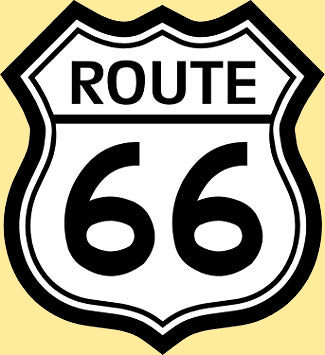 Ever
since the invention of the first automobile, America’s culture, economy,
and even its architecture has been defined by the road. Many people
associate roads with memories—a trip to grandma’s along a winding road
during a gentle snow, the new landscapes rolling by the backseat window
on the first big family vacation, a favorite drive where the automobile
and the road become one. One of these iconic highways, dubbed the
“Mother Road,” was U.S. Route 66. Ever
since the invention of the first automobile, America’s culture, economy,
and even its architecture has been defined by the road. Many people
associate roads with memories—a trip to grandma’s along a winding road
during a gentle snow, the new landscapes rolling by the backseat window
on the first big family vacation, a favorite drive where the automobile
and the road become one. One of these iconic highways, dubbed the
“Mother Road,” was U.S. Route 66.
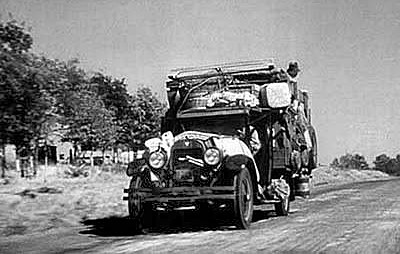 John
Steinbeck immortalized Route 66 in the Grapes of Wrath with his vivid
descriptions of the dirty and desperate faces of the “Okies” fleeing the
oppression of environmental degradation and financial injustice during
the dust bowl. And later he took his readers on a romantic driving
journey across the nation in Travels With Charley. William Least
Heat-Moon gave his readers Blue Highways and MGM gave audiences a
Technicolor yellow-brick road. John
Steinbeck immortalized Route 66 in the Grapes of Wrath with his vivid
descriptions of the dirty and desperate faces of the “Okies” fleeing the
oppression of environmental degradation and financial injustice during
the dust bowl. And later he took his readers on a romantic driving
journey across the nation in Travels With Charley. William Least
Heat-Moon gave his readers Blue Highways and MGM gave audiences a
Technicolor yellow-brick road.
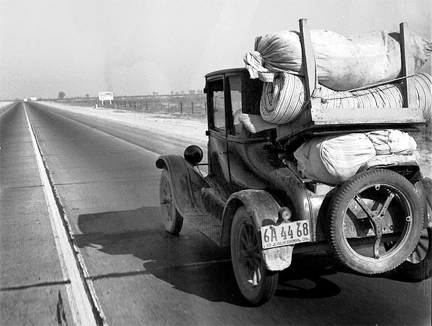 U.S.
Route 66 , also known as the Will Rogers Highway or the Main Street of
America, was one of the original highways within the U.S. highway
system. The U.S. Congress established it on November 11, 1926, with road
signs erected the following year. The highway originally ran from
Chicago, Illinois, through Missouri, Kansas, Oklahoma, Texas, New
Mexico, and Arizona before ending in Santa Monica, California, near Los
Angeles, spanning 2,448 miles. U.S.
Route 66 , also known as the Will Rogers Highway or the Main Street of
America, was one of the original highways within the U.S. highway
system. The U.S. Congress established it on November 11, 1926, with road
signs erected the following year. The highway originally ran from
Chicago, Illinois, through Missouri, Kansas, Oklahoma, Texas, New
Mexico, and Arizona before ending in Santa Monica, California, near Los
Angeles, spanning 2,448 miles.
 Route
66 served as a primary route for hundreds of immigrants from the Dust
Bowl in the 1930s. The road supported the economies of the communities
through which it passed. People doing business along it became
prosperous. As the route grew in popularity, business along it became
prosperous. Route
66 served as a primary route for hundreds of immigrants from the Dust
Bowl in the 1930s. The road supported the economies of the communities
through which it passed. People doing business along it became
prosperous. As the route grew in popularity, business along it became
prosperous.
Over its lifetime, Route 66 underwent many improvements and
realignments. The Government officially removed it from the nation’s
highway system in 1985. After it had been replaced by segments of the
Interstate Highway System, portions of the road passing through
Illinois, Missouri, New Mexico, and Arizona became a National Scenic
Byway with the name "Historic Route 66."
In 1857, the War Department ordered Lt. Edward Fitzgerald Beale, a Naval
officer in the service of the U.S. Army Corps of Topographical
Engineers, to build a government-funded wagon road along the 35th
Parallel. It also ordered him to test the feasibility of the use of
camels as pack animals in the southwestern desert. Eventually, this road
became part of Route 66.
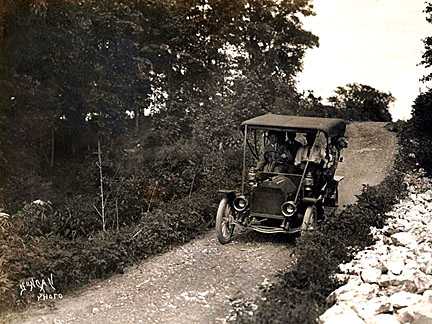 Before
the states adopted a nationwide network of numbered highways, private
organizations named and marked auto trails. The route that would become
US 66 consisted of three of these early highways. The Lone Star Route
passed through St. Louis on its way from Chicago to Cameron, Louisiana.
The transcontinental National Old Trails Road continued from St. Louis
to Los Vegas, New Mexico. And the National Old Trails Road which began
just south of there and continued to Los Angeles. Before
the states adopted a nationwide network of numbered highways, private
organizations named and marked auto trails. The route that would become
US 66 consisted of three of these early highways. The Lone Star Route
passed through St. Louis on its way from Chicago to Cameron, Louisiana.
The transcontinental National Old Trails Road continued from St. Louis
to Los Vegas, New Mexico. And the National Old Trails Road which began
just south of there and continued to Los Angeles.
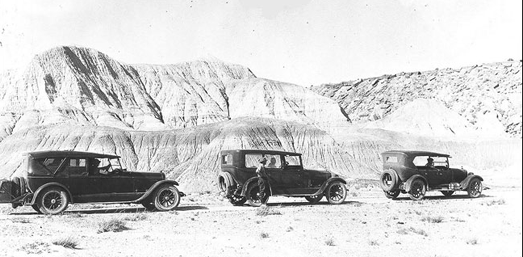
The original inspiration for a roadway between Chicago and Los Angeles
came from entrepreneurs Cyrus Avery of Tulsa, Oklahoma, and John
Woodruff of Springfield, Missouri.
How Route 66 Came to Be
Route 66 received its numerical designation on April 30, 1926 in
Springfield, Missouri. Championed by Avery when the first talks about a
national highway system began, Route 66 became one of the original U.S.
highways in 1927.He was adamant that the highway have a round number and
had proposed the number 60 to identify it. After many arguments, Avery
and highway engineer John Page settled on the number "66," which had yet
to be assigned.
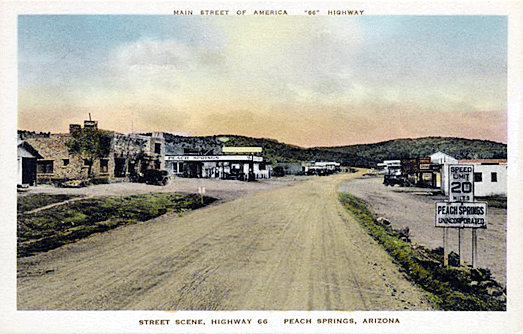
Traffic grew on the highway because of the geography through which it
passed. Since much of the highway was essentially flat, it became a
popular truck route. The Dust Bowl of the 1930s saw many farming
families, mainly from Oklahoma, Arkansas, Kansas, and Texas, heading
west for agricultural jobs in California.
During the Depression, the route helped create many mom-and-pop
businesses, such as service stations, restaurants, and motor courts, all
easily accessible to passing motorists.

Much of the early highway, like all the others, was gravel or graded
dirt. Route 66 became the first highway to be completely paved in 1938.
But it did have some dangerous curves, earning part of it the nickname
of "Bloody 66." Gradually, the Government realigned many of these bad
segments to remove dangerous curves. However, one section through the
Black Mountains outside Oatman, Arizona, had hairpin turns and was the
steepest along the entire route, so much so that some early travelers,
too frightened at the prospect of driving such a potentially dangerous
road, hired locals to navigate the winding grade. The section remained
part of Route 66 until 1953 and is still open to traffic today as the
Oatman Highway.
Buildings Along the Way
Notable structures along Route 66 include the Art Deco–styled U-Drop
Inn, constructed in 1936 in Shamrock, in Wheeler County east of
Amarillo, Texas, and now listed on the National Register of Historic
Places. There’s also a restored Magnolia fuel station located in
Shamrock as well as Vega, in Oldham County, west of Amarillo.
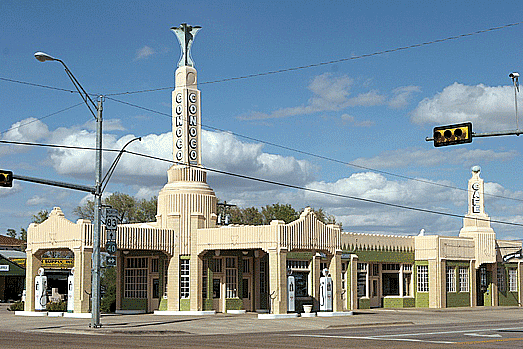
During World War II, more migration west occurred because of war-related
industries in California. US 66, already popular and fully paved, became
one of the main routes and also served for moving military equipment.
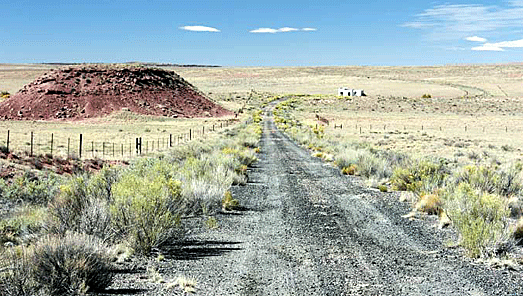
In the 1950s, Route 66 became the main highway for vacationers heading
to Los Angeles. The road passed through the Painted Desert and near the
Grand Canyon. Meteor Crater in Arizona was another popular stop. This
sharp increase in tourism in turn gave rise to a variety of roadside
attractions, including teepee-shaped motels, frozen custard stands,
Indian curio shops, and reptile farms. Meramec Caverns near St. Louis,
began advertising on barns, billing itself as the "Jesse James hideout."
The Big Texan advertised a free 72-ounce steak dinner to anyone who
could consume the entire meal in an hour.
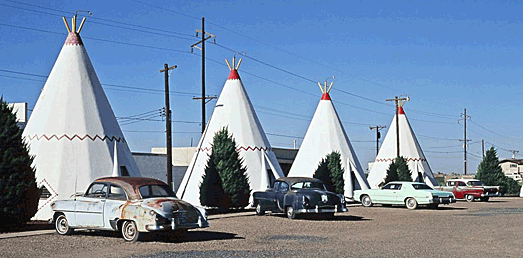
Route 66 marked the birth of the fast-food industry. Red's Giant Hamburg
in Springfield, Missouri, was the site of the first drive-through
restaurant, as well as the first McDonald's in San Bernardino,
California. The route became a near-perfect microcosm of the culture of
America, now linked by the automobile.
The Beginning of the End
The beginning of the decline for US 66 came in 1956 with the signing of
the Interstate Highway Act by President Dwight D. Eisenhower who was
influenced by his experiences in 1919 as a young Army officer crossing
the country in a truck convoy and an appreciation of Germany’s autobahn
network as a necessary component of a national defense system.
During its nearly 60-year existence, Route 66 underwent constant change.
As highway engineering became more sophisticated, engineers constantly
sought more direct routes between cities and towns. Increased traffic
led to a number of major and minor realignments of Route 66 through the
years, particularly in the years immediately following World War II.

Although it’s no longer possible to drive US 66 uninterrupted from
Chicago to Los Angeles, much of the original route and alternate
alignments are still drivable with careful planning.
Over its lifetime, Route 66 underwent many improvements and
realignments. The Government officially removed it from the nation’s
highway system in 1985. After it had been replaced by segments of the
Interstate Highway System, portions of the road passing through
Illinois, Missouri, New Mexico, and Arizona became a National Scenic
Byway with the name "Historic Route 66."
Preserving the Past
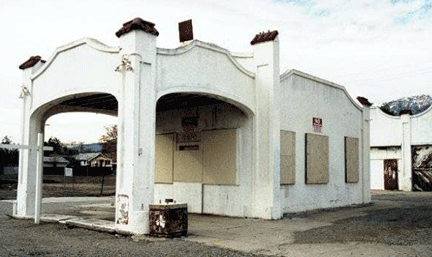 All
along Historic Route 66, preservation efforts are under way to preserve
original buildings. The route was also responsible for the founding of
many chain stores back in the 1920s that sprouted up next to it to
increase business and sales. But when the US 66 signs disappeared,
businesses along it were forced to close because motorists couldn’t find
them. All
along Historic Route 66, preservation efforts are under way to preserve
original buildings. The route was also responsible for the founding of
many chain stores back in the 1920s that sprouted up next to it to
increase business and sales. But when the US 66 signs disappeared,
businesses along it were forced to close because motorists couldn’t find
them.
American pop-culture artists publicized Route 66 and the experience of
driving it, through song and television. Bobby Troup wrote "(Get Your
Kicks on) Route 66", and the highway lent its name to a TV series in the
1960s that still plays today on Retro TV.
<
More Special Features
Next Article >
|
